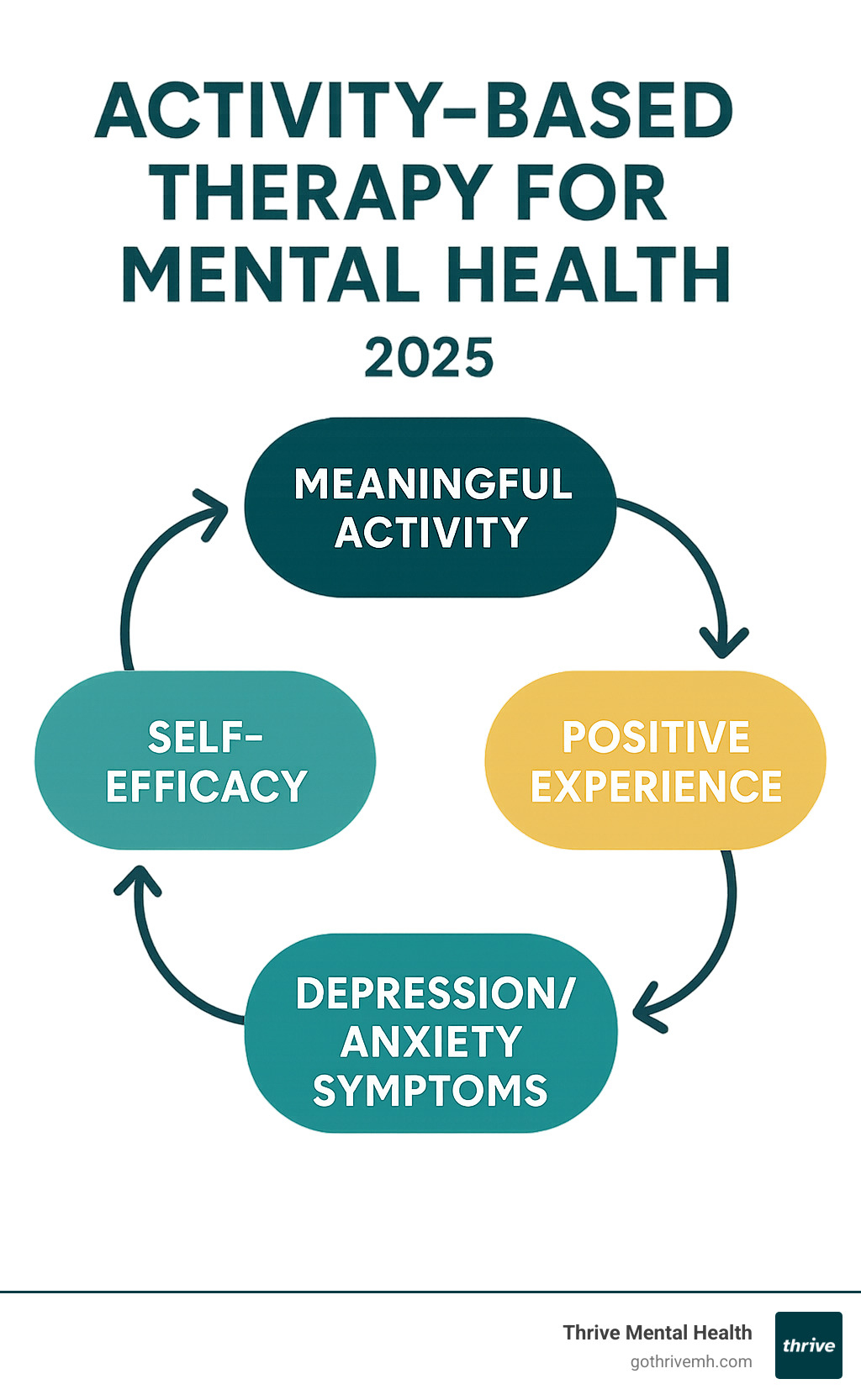Therapy in Action: Why Activity-Based Approaches Work Wonders

Why Activity-Based Therapy is Changing Mental Health Treatment
Activity based therapy mental health approaches are revolutionizing how we think about healing and recovery. Instead of sitting in a chair talking about problems, this therapeutic method gets you actively engaged in meaningful activities that directly address your mental health challenges.
What Activity-Based Therapy Includes:
- Creative activities – Art, music, writing, and crafts
- Physical activities – Yoga, walking, sports, and movement
- Life skills – Cooking, gardening, and daily living tasks
- Social activities – Group projects and community engagement
- Mindfulness practices – Nature walks and meditation
Key Benefits:
- Reduces anxiety and depression symptoms
- Builds practical coping skills
- Increases self-confidence and self-efficacy
- Creates social connections and support
- Provides immediate sense of accomplishment
Research shows that participants in activity-based group therapy report moderate to high self-efficacy (averaging 6.92 on a 10-point scale) and experience higher happiness scores while showing lower anxiety levels. Studies consistently demonstrate that activity-based approaches can be more effective than traditional talk therapy alone for many conditions.
The power of this approach lies in its fundamental principle: action precedes emotion. When you engage in purposeful activities, you’re not just talking about change – you’re actively creating it through movement, creativity, and meaningful engagement.
I’m Nate Raine, CEO of Thrive Mental Health, where I’ve spent over a decade developing innovative behavioral health solutions that integrate activity based therapy mental health approaches into comprehensive treatment programs. My experience leading both clinical operations and strategic partnerships has shown me how activity-based interventions can accelerate recovery and create lasting change for clients struggling with anxiety, depression, and other mental health challenges.

What is Activity-Based Therapy? Beyond Just Talking
Imagine healing through doing rather than just talking. That’s the heart of Activity-Based Therapy (ABT) – a refreshing approach where your therapist guides you through meaningful, purposeful activities designed to help you reach specific healing goals.
While traditional talk therapy focuses on verbal processing, activity based therapy mental health approaches use engagement in activities as the main path to recovery. Instead of sitting in a chair discussing your struggles, you’re actively creating change through movement, creativity, and hands-on experiences.
Think of it as taking a more relaxed road to recovery – one where you find insights about yourself while gardening, painting, cooking, or moving your body. The magic happens when action leads to emotional breakthroughs and skill development in ways that feel natural and empowering.

The Foundations of activity based therapy mental health
What makes activity based therapy mental health so effective is its thoughtful structure. This isn’t about randomly throwing activities at you and hoping something sticks. Each session is carefully planned around your unique needs, interests, and therapeutic goals.
Your therapist works with you to create structured sessions that build skills step-by-step. Together, you’ll set clear objectives and develop an individualized plan that feels meaningful to you. This might mean learning coping strategies through art, building confidence through cooking, or processing trauma through gentle movement.
The American Psychological Association defines Activity Therapy as “any type of therapy based on one or more of various activities, such as arts and crafts, exercise, music, and drama.” This broad definition shows just how versatile this approach can be.
Activity based therapy mental health draws wisdom from two well-established fields. Occupational Therapy focuses on helping people engage in meaningful daily activities – from self-care routines to work and leisure pursuits. Meanwhile, Recreational Therapy uses play, leisure, and recreation as healing tools, recognizing that joy and engagement are powerful medicine.
Both approaches share a beautiful belief: that participating in meaningful activities is essential for human well-being. They put you at the center of your healing journey, promoting your independence and natural motivation to grow.
A Glimpse into History: The Evolution of Healing Through Action
The idea of healing through activity isn’t some modern fad – it has roots stretching back thousands of years. Ancient Roman physicians like Asclepiades prescribed exercise, massage, and baths for mental distress, understanding the connection between body and mind long before we had the science to prove it.
The moral treatment movement of the 18th century brought this wisdom into formal mental health care. Pioneers like Benjamin Franklin and Philippe Pinel believed that meaningful work and recreation could restore mental balance. They encouraged activities like spinning, farming, and crafts as part of treatment – recognizing that purposeful engagement helped people reconnect with their sense of worth and capability.
The early 1900s marked a turning point, especially after World War I. Veteran care programs used activities like knitting, basket weaving, and rug making to help soldiers recover from what we now know as PTSD. This period proved that “occupation” – meaningful activity – was as essential to healing as any medicine.
William Rush Dunton, who founded the American Occupational Therapy Association, captured this perfectly in 1919: “occupation is as necessary to life as food and drink… sick minds, sick bodies, sick souls may be healed through occupation.”
By 1954, the American Psychiatric Association officially recognized Activity Therapy as a legitimate treatment. Today’s activity based therapy mental health programs build on this rich history, now backed by modern research on brain plasticity and recovery. You can explore more about the historical roots of therapeutic recreation to see how this time-tested approach continues to evolve.
At Thrive Mental Health, we honor this legacy while embracing cutting-edge understanding of how movement and purposeful engagement can transform mental well-being.
The Psychological and Physiological Benefits of Activity Based Therapy for Mental Health
Here’s something beautiful about activity based therapy mental health approaches: they work with your whole self, not just your thoughts. Your mind and body are deeply connected, and when one heals, the other follows. This isn’t just feel-good philosophy—it’s backed by solid research showing how engaging in meaningful activities creates real, measurable changes in both your brain and your overall well-being.
How Doing Rewires the Brain and Body
When you’re struggling with depression or anxiety, your brain often gets stuck in unhelpful patterns. The good news? Every time you engage in purposeful activity, you’re literally rewiring your brain for the better.
Behavioral Activation is one of the most powerful tools we use in activity-based therapy. It’s based on a simple but profound idea: action comes before feeling. When depression tells you to stay in bed, behavioral activation says “let’s do something small anyway.” You don’t wait to feel motivated—you act first, and motivation follows.
This approach directly challenges the avoidance cycles that keep people stuck. Instead of withdrawing from life, you gradually re-engage through structured activities. Research shows this can be just as effective as traditional therapy or medication for treating depression.
Your brain’s ability to change and adapt—called neuroplasticity—is constantly at work. Every new skill you learn, every creative project you tackle, every walk you take is helping your brain form new, healthier pathways. It’s like creating new roads in your mind that lead to better places.
Physical activity triggers endorphin release—those natural mood boosters that make you feel genuinely better. Even gentle movement can shift your brain chemistry in positive ways. At the same time, engaging in calming or enjoyable activities helps reduce cortisol, your body’s main stress hormone.
A scientific review on activity-based therapies found that these approaches don’t just improve mental health—they boost physical health too, lowering blood pressure, strengthening the immune system, and reducing stress hormones throughout the body.
Key Benefits for Overall Well-being
The ripple effects of activity-based therapy extend far beyond just feeling a bit better. Research shows participants report moderate to high self-efficacy (averaging nearly 7 out of 10), along with higher happiness scores and lower anxiety levels. More importantly, the coping skills developed through activities create a positive chain reaction—better coping leads to greater confidence, which leads to improved overall well-being.
Boosting self-esteem happens naturally when you complete activities successfully. Whether you’re finishing a painting, cooking a meal, or simply taking a walk, each accomplishment builds confidence and proves to yourself that you’re capable of positive change.
Reducing symptoms of depression and anxiety occurs as you break free from cycles of rumination and withdrawal. Instead of getting lost in worried thoughts, you’re actively engaged with the world around you. Physical activities are especially powerful here—exercise is proven to significantly decrease anxiety and depression while lifting overall mood.
Providing healthy coping mechanisms gives you practical tools for managing difficult emotions. Rather than turning to harmful habits when stress hits, you learn to reach for a paintbrush, lace up walking shoes, or call a friend from your therapy group.
Improving social skills and connection happens naturally in group activities. Many people struggling with mental health feel isolated, but activity-based therapy creates opportunities for genuine connection and support. You’re not just talking about problems—you’re creating positive experiences together.
Fostering a sense of accomplishment and purpose might be the most transformative benefit of all. When you engage in activities that align with your values and interests, you refind reasons to look forward. This sense of purpose becomes a powerful antidote to feelings of hopelessness or emptiness.
The beauty of activity based therapy mental health approaches is that these benefits build on each other. Each positive experience makes the next one more likely, creating an upward spiral of healing and growth.
Putting Therapy into Practice: Examples and Customization
One of the most exciting things about activity based therapy mental health is how flexible it can be. There’s no cookie-cutter approach here – it’s all about working together with your therapist to find what clicks for you. This collaboration creates a treatment plan that actually fits your life, interests, and goals.
Think of it like finding the right key for a lock. What open ups healing for one person might be completely different for another. That’s why we take time to understand who you are, what you enjoy, and what you’re hoping to achieve.

Common Activities Used in Mental Health Treatment
The world of activity-based therapy is wonderfully diverse. Let me walk you through some of the most effective approaches we use:
Creative arts offer incredible outlets for emotions that might be hard to put into words. Whether it’s painting your feelings onto canvas, writing poetry about your experiences, or playing music that speaks to your soul, creative activities help you express yourself in new ways. Drama therapy can be especially powerful – sometimes acting out different scenarios helps you practice handling real-life situations.
Physical activities are like medicine for both body and mind. Yoga combines movement with mindfulness, helping you feel more grounded. Walking therapy gets you moving while you talk – many people find they open up more easily when they’re not sitting face-to-face in a traditional office setting. Even gentle exercises can release those mood-boosting endorphins we talked about earlier.
Life skills activities might sound basic, but they’re incredibly empowering. Cooking a meal from scratch, tending a garden, or learning to manage daily tasks can restore your confidence and sense of independence. These activities prove to yourself that you can handle real-world challenges.
Mindfulness practices help quiet the noise in your head. Nature walks are particularly healing – there’s something about being outdoors that naturally reduces stress. Even if you can’t get outside easily, we can bring nature to you through virtual experiences or indoor plants.
Social activities combat the isolation that often comes with mental health struggles. Group projects, volunteer work, or even simple games help you connect with others who understand what you’re going through. Research shows that exploring meaningful activities in therapy creates lasting positive changes.
Tailoring Activities to Individual Needs
Here’s where the magic really happens – making it all about you. Your therapist becomes like a detective, learning what makes you tick so they can design the perfect therapeutic experience.
Your interests matter most. Love music but hate sports? We’ll focus on musical activities. Enjoy being outdoors but feel anxious in groups? We’ll start with solo nature activities. The goal is to build on what already brings you joy or curiosity.
Your therapeutic goals shape everything we do. If you’re working on anxiety, we might use grounding exercises or calming activities like gardening. For depression, we often focus on activities that create a sense of accomplishment and connection. Trauma recovery might involve expressive arts or movement therapies that help you reconnect with your body safely.
Physical abilities are always considered. Everyone deserves access to healing activities, regardless of physical limitations. We adapt everything – from chair yoga to modified art projects – so you can participate fully and safely.
Cognitive function guides how we structure activities. Some days your brain might feel foggy, and that’s okay. We can simplify activities or break them into smaller steps. The important thing is that you’re engaged at whatever level feels right for you.
Creating your personalized plan starts with understanding what you value most in life. Maybe it’s creativity, helping others, or staying healthy. Once we know your values, we can choose activities that feel meaningful rather than just therapeutic.
For example, if you value helping others but struggle with social anxiety, we might start with behind-the-scenes volunteer work and gradually work up to more direct interaction. If you value creativity but feel “stuck,” we might begin with simple art exercises that focus on the process rather than the outcome.
This personalized approach ensures that your journey with activity based therapy mental health feels authentic to who you are. It’s not about forcing yourself into activities that don’t fit – it’s about finding new ways to heal that actually make sense for your life.
Who Can Benefit and What to Consider
Activity based therapy mental health approaches offer hope and healing for a remarkably wide range of people and situations. The beauty of this therapeutic method lies in its practical, hands-on nature, making it especially valuable for those who find traditional talk therapy challenging or insufficient on its own.

Ideal Candidates for Activity-Based Therapy
If you’re struggling with depression, you might find that getting out of bed feels impossible, let alone engaging in activities. This is exactly why Activity-Based Therapy can be so powerful. By focusing on behavioral activation, we help you break the cycle of withdrawal and inactivity that feeds depression. Even small accomplishments – like completing a simple art project or taking a short walk – can create positive momentum and lift your mood naturally.
Anxiety disorders respond beautifully to the grounding nature of purposeful activities. When your mind is racing with worried thoughts, engaging your hands in pottery or your body in gentle yoga can bring you back to the present moment. Physical activities provide healthy outlets for that nervous energy, while creative expression helps you process anxious feelings in a non-threatening way.
For those dealing with Post-Traumatic Stress Disorder (PTSD), talking about traumatic experiences can sometimes feel overwhelming or retraumatizing. Movement-based therapies, art therapy, and other experiential approaches allow you to process trauma through your body and creative expression when words feel inadequate or unsafe.
Substance use disorders often involve replacing harmful coping mechanisms with healthy ones. Activity-Based Therapy excels here by helping you find new sources of joy, accomplishment, and social connection. Whether it’s learning to cook nutritious meals, joining a hiking group, or expressing yourself through music, these activities become positive alternatives to substance use.
Young people with neurodevelopmental disorders like ADHD often thrive with movement-integrated therapies. When sitting still feels impossible, incorporating sports, dance, or other physical activities into therapy sessions can improve focus, emotional regulation, and self-confidence.
Some individuals simply struggle with verbal expression – maybe you’re not naturally talkative, or perhaps you’ve experienced trauma that makes speaking difficult. Activity-Based Therapy offers non-verbal pathways to healing, allowing emotions and insights to emerge through action rather than words.
Finally, if you’ve been in traditional therapy and feel “stuck” or plateaued, introducing activities can provide the breakthrough you need. Sometimes our bodies and hands know things our minds haven’t figured out yet, and engaging in purposeful activities can open up new perspectives and healing pathways.
Challenges in implementing activity based therapy for mental health
While activity based therapy mental health approaches offer tremendous benefits, I want to be honest about some practical challenges you might encounter. Understanding these upfront helps you make informed decisions and find the best path forward.
Finding qualified therapists who specialize in specific activity-based approaches can be tricky, especially if you’re looking for something specialized like equine therapy or psychodrama. Not every area has therapists trained in these methods, and it’s crucial to work with professionals who understand both the activity and its therapeutic application.
Cost and insurance coverage can vary significantly. Some specialized experiential therapies may be more expensive than traditional talk therapy, and your insurance might not cover all approaches equally. At Thrive Mental Health, we work with you to understand your coverage and find accessible options that fit your needs and budget.
Accessibility extends beyond just finding qualified providers. Some activities might not be suitable if you have physical limitations, though most can be adapted creatively. The key is working with therapists who are skilled at modifying activities to meet your specific abilities and needs.
Client motivation can be a real hurdle, especially when you’re dealing with severe depression or apathy. The thought of engaging in activities might feel overwhelming when you can barely manage daily tasks. This is where the “action precedes emotion” principle becomes crucial – your therapist will help you start small and build momentum gradually, understanding that motivation often follows action rather than preceding it.
Integrating with other treatments requires careful coordination. If you’re taking medication or working with multiple providers, it’s important that your activity-based therapy complements rather than conflicts with your other treatments. The most effective approach often combines activity based therapy mental health methods with other evidence-based treatments as part of a comprehensive care plan.
These challenges highlight why choosing the right program matters so much. You deserve care that’s not only evidence-based and expert-led, but also flexible enough to work around these practical considerations and accessible enough to fit into your real life.
Conclusion: Taking the First Step Towards Active Healing
Activity based therapy mental health represents a powerful shift in how we approach healing and recovery. Instead of staying stuck in cycles of overthinking or feeling overwhelmed by traditional therapy approaches, you can literally move your way toward better mental health.
Throughout this journey together, we’ve explored how purposeful activities can rewire your brain, reduce anxiety and depression symptoms, and help you build the practical coping skills you need to thrive. We’ve seen how action precedes emotion – meaning you don’t have to wait until you feel better to start doing things that make you feel better.
Healing is a journey, not a destination. Some days will be harder than others, and that’s completely normal. What matters is having the right tools and support to keep moving forward, even when motivation feels low.
The beauty of activity-based approaches lies in their immediate impact. When you engage in meaningful activities – whether it’s creating art, moving your body, connecting with nature, or learning new skills – you’re not just passing time. You’re actively creating positive change in your brain and body, building confidence with each small step forward.
Action becomes the catalyst for lasting change. Every pottery class attended, every nature walk completed, every group activity participated in becomes proof that you’re capable of more than your anxiety or depression wants you to believe. These experiences accumulate into a stronger sense of self and renewed hope for your future.
At Thrive Mental Health, we’ve witnessed countless individuals find their strength through active engagement. Our programs integrate these evidence-based activity approaches into comprehensive care that meets you where you are – whether you’re joining us virtually or in person.
If you’re ready to move beyond just talking about your challenges and start actively addressing them, we’re here to support you every step of the way. Recovery is possible, and you don’t have to steer this journey alone. Learn more about our evidence-based IOP and PHP programs and find how we can help you build a life filled with purpose, connection, and genuine well-being.
Your healing journey starts with a single step. Why not make it an active one?

One thought on “Therapy in Action: Why Activity-Based Approaches Work Wonders”
Comments are closed.